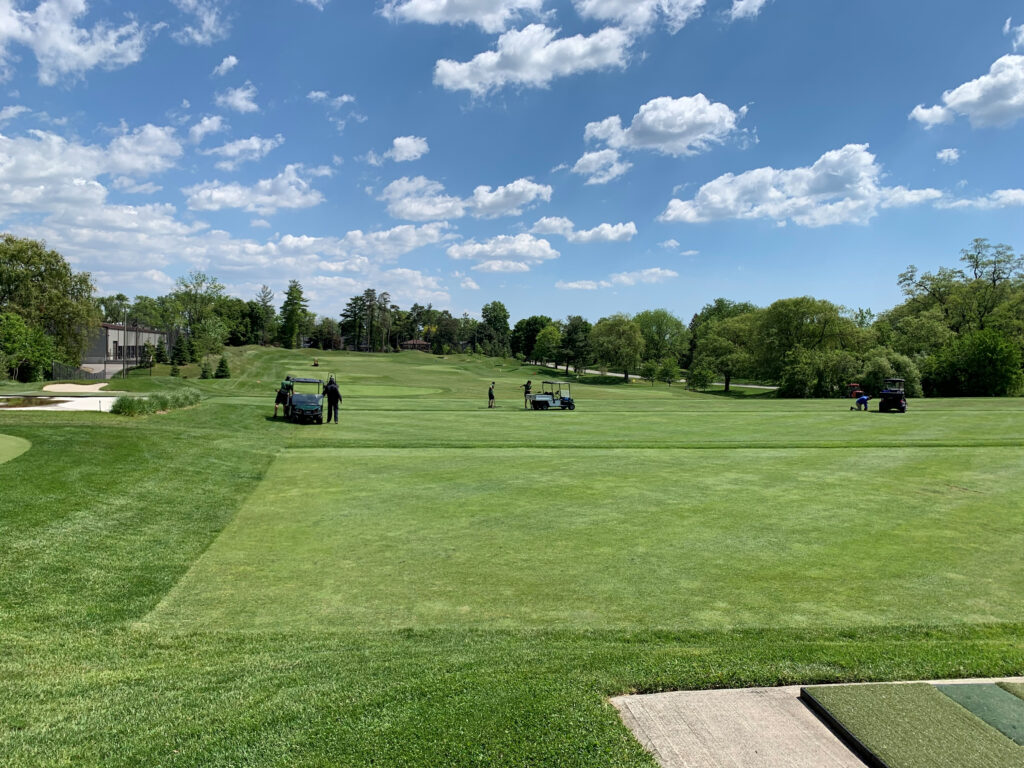The driving range at Credit Valley is an excellent practice facility for you to work on your playing skills. Following the reconstruction of the range in 2016, we are fortunate to have the following amenities:
- 43,000 square feet of tee deck space, allowing us ample tee deck space for use from May to October, six days a week.
- Eight target greens, totalling 10,000 square feet. These greens are bentgrass to give the same look and ball receptiveness that you would experience on the golf course.
- Two bunkers, one on each side of the range, to provide the opportunity to hit both short- and long-range shots.
Each Tuesday, the Greens Department completes the majority of our weekly driving range maintenance. Although there may be minor variability depending on the event schedule or holidays, the range is closed for use from 10:00 am-2:30 pm each Tuesday. The schedule is included in the golf calendar on the Club’s website for your reference. It is important to note that during the maintenance window on Tuesdays, the putting greens and short game area remain open for use.
Mowing
All of the turf on the driving range, driveway, and around the putting greens is cut on Tuesdays during the maintenance window. With only cutting the rough once a week, compared to rough on the course two to three times, we typically require time to clean up extra grass clippings left behind the cutting.

With the proximity to the houses on the north side of the driving range and the noise by-law requirements, we cannot perform many tasks before 7:00 am. We complete a second cut of the fairway and greens on Friday mornings before the range opening for the day.
The mowing of the tee decks is impossible in the morning before the range opens because of the noise by-law and opening time. To complete the mowing of the tee decks more than once a week, we perform an evening cut on the tees Sunday and Thursday evenings beginning at 7:00 pm.
Divots
Each day the divots are filled on the driving range to ensure seed germination as quickly as possible. In 2020, we were able to complete the repair of previous divots in the morning before opening; this was a benefit of a later start to the tee sheet and driving range opening. Each evening the back shop staff removes and discards any divot remains then fills the voids with a new mix. On Tuesdays, during range maintenance, we refill any divots that have been partially or completely washed away following a rain event before the germination.
Other Tasks
In addition to mowing and divot filling, we complete several other tasks during Tuesday’s maintenance period.
- Fertility applications
– To ensure ample growth and germination, the driving range is fertilized more often than any other area of the course - Pest control product applications
– Insects, disease pressure, and weed management are all applications that must be completed during the maintenance window - Detail work for aesthetics and health of equipment or trees
– Sprinkler edging
– Bunker maintenance
– Tree mulch weeding and edging
– Tree watering
Many of these practices cannot be completed simultaneously by the staff in the same area for safety or efficacy. This necessitates the need for a closure of four and a half hours each week.

The maintenance schedule of the driving range is a very busy time. Typically there is a dozen or more staff on the range performing tasks. The staff required to complete the work in a four-and-a-half-hour timespan is over half of the staff working in the department during the afternoon. Having the opportunity to complete this at once with the resources and allotment needed is paramount for a successful practice facility.


Thanks chris….good update on range maintenance…gives me a better overall understanding of your efforts..
Thanks for the detail of the tasks and work involved, Chris!
Nice pickup on the green speed this weekend.
Appreciatively,
Alan Forde
Good Morning Chris; A big hanks to you and your team for maintaining the course in tip top shape. The speed of the greens is wonderful. Hopefully #16 green will respond to your efforts. Paul
Can you tell us why the nursery green turf was not used to repair the 16th green damage this spring? I always thought that was the reason for the nursery green’s existence.
The 16th green is in a very specific growing environment. With the shade, lack of air movement, and water runoff from the hill; the species of turf that is successful during the growing season is incredibly specific to that site. Whether utilizing sod from an outside source or the nursery, to replace the damaged areas the likelihood of success long term is low. By seeding into the existing profile and utilizing the existing seed bank of a favourable turf type for the area, we can promote the growth of a plant that can tolerate the growing environment.